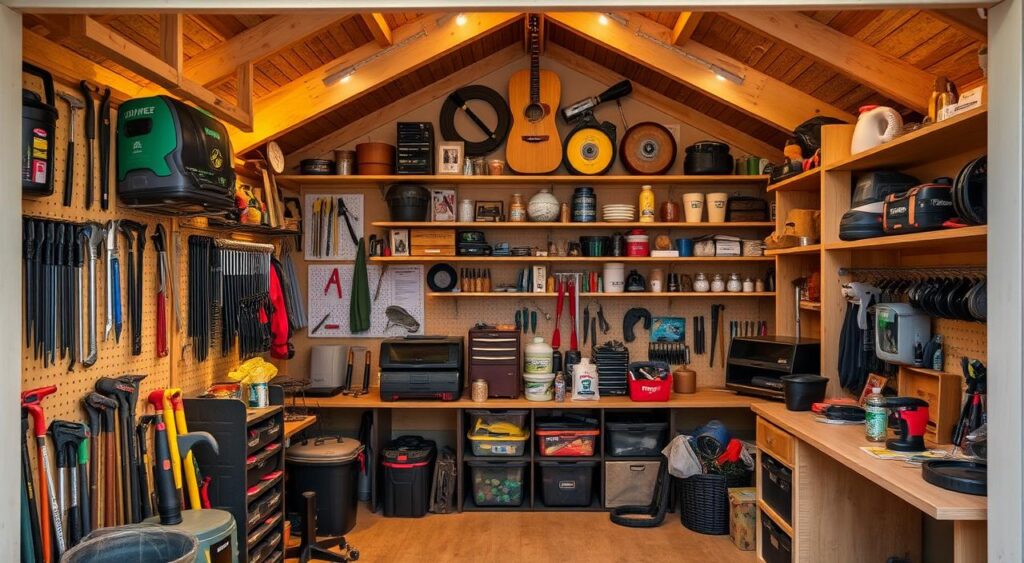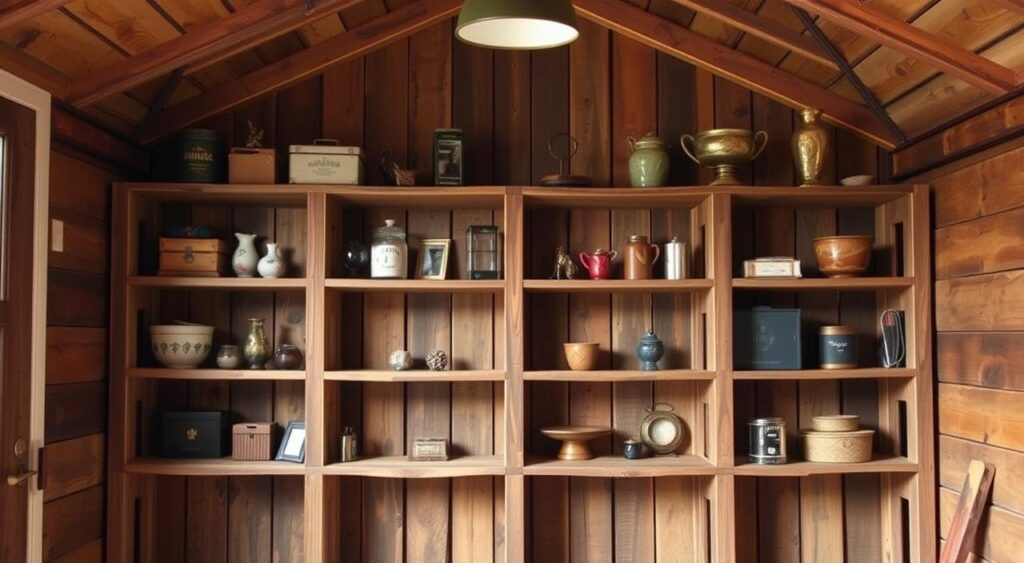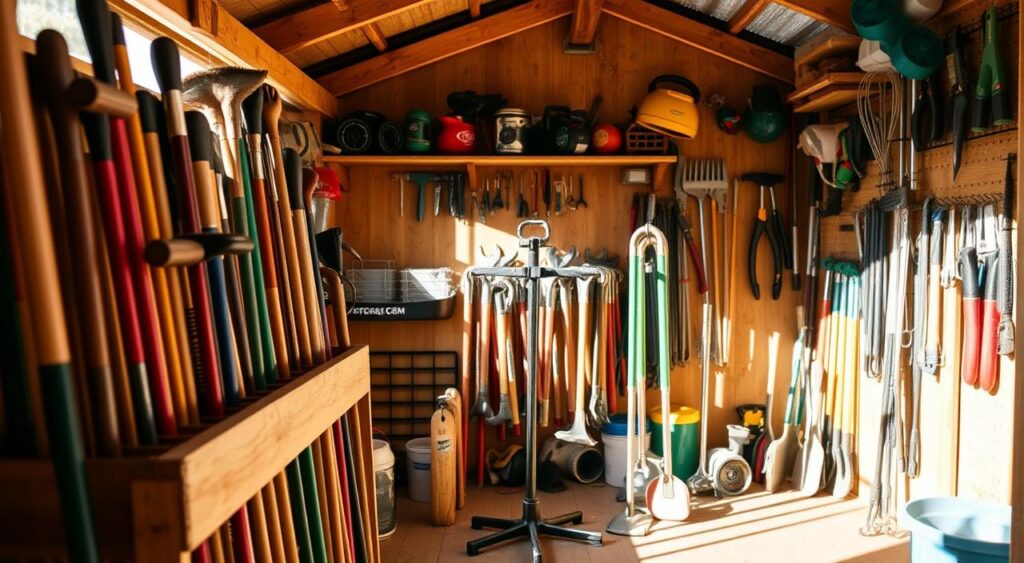Across the UK, the Great British Shed has earned its place as more than a garden outbuilding. It’s a space where tools, bicycles, keepsakes, and half-finished projects come together. Yet without organisation, it can quickly tip from charming to chaotic.

This guide explores why sheds matter so much in Britain — and how to make yours work better with clever storage, from shelving and hooks to upcycling ideas.
Key Features of a Well-Organised Shed
- Heavy-duty shelving (rated up to 175kg per shelf) for power tools and bulky items.
- Pegboards and magnetic strips to keep hand tools visible and easy to reach.
- Wheeled trunks and totes for portable, seasonal storage.
- Hooks and racks that reclaim floor space and lift tools off the ground.
- Upcycled furniture (cupboards, chemist drawers, bookcases) for budget-friendly storage.
- Workshop bench with under-counter drawers for DIY zones.
- Ceiling racks and bike hoists to maximise vertical space.
| Feature | Benefit | Best Use Case |
|---|---|---|
| Heavy-duty shelving | Holds up to 175kg per tier | Power tools, compost, bulky boxes |
| Pegboard panels | Flexible tool layout | Hand tools, seeds, and accessories |
| Magnetic strips | Fast grab-and-go storage | Screwdrivers, pliers, paintbrushes |
| Wheeled trunk (110L) | Portable, weatherproof organisation | Seasonal gear; move between shed & lawn |
| Upcycled furniture | Low-cost, eco-friendly storage | Seeds, labels, hidden compartments |
Quick Wins for a Tidier Shed
Small, affordable changes often bring the biggest results. Heavy-duty hooks, wall racks, and tote bags can instantly reclaim floor space. A wheeled trunk for seasonal kit or a 29-drawer organiser for screws saves time and effort when tackling jobs.
Walls that Work: Pegboards and Tool Racks
One of the most effective upgrades for any shed is wall storage.
- Pegboards create flexible layouts with hooks and trays.
- Magnetic strips keep screwdrivers, pliers, and even paintbrushes in view.
- Tool silhouettes marked on walls remind you where items belong.
Mount panels into strong studs for safety, and leave space for new tools so your system can grow.
Heavy-Duty Shelving for Bigger Loads
When bulkier equipment builds up, shelving becomes essential. Metal units rated up to 175kg per tier keep power tools, compost bags, and storage boxes safe. Adjustable shelves let you customise spacing for awkward items.
Tip: place heavy items low, everyday tools at eye level, and seasonal boxes higher up.
Smarter Small-Item Organisation

Fiddly items are often the main cause of clutter. A labelled drawer unit keeps screws, wall plugs, and drill bits separate. Clear bins and waterproof totes make seed packets, twine, and gloves easy to find.
Regularly review drawers and bins each season to clear out duplicates and top up essentials.
Long-Handled Tool Storage
Shovels, rakes, and spades usually end up in an untidy pile. Prevent this with:
- A DIY pallet rack screwed to the wall.
- A freestanding tool tidy for forks and spades.
- Hooks on the back of the shed door for lightweight items.
Grouping by task — digging vs sweeping — makes retrieval faster.
Vertical and Overhead Storage
Look upwards to free even more space.
- Ceiling racks for lightweight seasonal gear.
- Bike hoists to lift bicycles off the floor.
- Hose hangers using reels or spools to stop tangles.
Always check clearances for lights and doors before installing overhead solutions.
Portable Storage: Trunks and Totes
Some jobs move between the shed and the garden. A 110-litre wheeled trunk is perfect for bulkier kit, while a gardening tote with pockets holds essentials like secateurs and twine.
Buy a pair of trunks to separate clean items from muddy ones, and stack them when not in use.
Budget-Friendly Upcycling

Repurposing old furniture creates charm as well as function:
- Chemist cabinets or card drawers are perfect for seed packets.
- Kitchen worktops make rugged benches with cupboards below.
- Bookcases refreshed with paint serve as open shelving.
This approach keeps costs low while adding character.
Building a Workshop Zone
If your shed doubles as a workshop, a counter-height bench with drawers underneath is invaluable. Fit pegboards and magnetic strips above for rapid access to tools, and add shallow shelves for consumables.
A task light, rubber mat, and fire extinguisher keep the area safe and practical.
Planning Your Layout
Good planning is the secret to long-term success.
- Measure door swings and aisle widths before installing shelves.
- Group items by frequency of use.
- Keep heavy kit low and lighter items higher.
- Review each season to keep clutter under control.
Conclusion
The Great British Shed is part of our national identity — but it doesn’t need to be a dumping ground. By combining quick fixes like hooks and organisers with bigger investments such as shelving and wheeled trunks, you can turn a cluttered corner into a productive space.
Whether you’re gardening, repairing, or simply storing, an organised shed saves time, reduces stress, and makes the space more enjoyable year-round.
👉 If your shed is too full to tackle alone, professional help is available through shed clearance removal in London , making the process quicker and stress-free.





